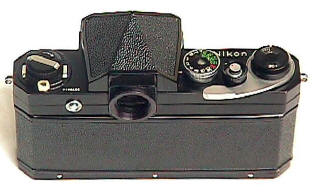Sold Items » Household Items » Rock Hudson
NIKON F CAMERAPrice: $ 1,900.00 (Sold Items » Household Items » Rock Hudson) | ||||||||||||||||||||||
SOLD I JUST FOUND PAPERWORK THAT DEFINITELY ESTABLISHES THAT THIS WAS ORIGINALLY OWNED BY ROCK HUDSON!!! IT WAS USED BY GEORGE NADER AND EVENTUALLY HE INHERITED IT. THIS WAS THE CAMERA THAT ROCK USED TO TAKE ALL HIS PERSONAL PHOTOS THAT I HAVE ON MY SITE. WHAT A GREAT FIND!! I WILL ADD MORE INFORMATION AFTER I READ MORE ABOUT THIS.
It has a low serial number, leather case, strap, external flash & A BOOK! It is in like new condition. It has always been kept in it's case. Below I am attaching a bit of information about the camera. Background: This was a real turn around folks, and to understand it, we will have to look at 35mm photography in 1959. While the Japanese were the up and coming new boys on the block, everyone knew that the Germans were the undisputed leaders. Leica was far and away the best selling professional Rangefinder camera. Rollei's TLR was the pro's choice in 120 cameras. And then of course there were the marvelously sharp Zeiss optics on the awkward but superlatively made Contax and Contarex. Japan was where the cheap cameras came from. You bought Japanese if you couldn't afford German. SLR's? 35mm SLR's were generally slow working cameras with no instant return mirrors and no automatic diaphragm. Don't know what I'm talking about? After an exposure, the mirror on most 35mm SLR's did not return into viewing position until you advanced the film. In other words, you were stuck looking at a black hole. The instant return mirror came to market on the Asahiflex IIb of 1953--but not everyone was quick to adapt it. And then there was the little matter of the lens diaphragm. If you had just taken a picture at f/16 and you were lucky enough to be using a camera with an instant return mirror, you still didn't have a clear view after the exposure because the camera lens was still at f/16. The bright image you had was now dim, until you manually opened up your lens to its maximum aperture. Until automatic diaphragm lenses for SLRs started showing up. They would automatically open the lens back up to its maximum aperture after exposure. Manufacturer after manufacturer in the late 50's kept introducing their idea of the SLR of the future, with all the bells and whistles. While some of them, notably Pentax, seemed to be on the right track, none of them really had a Professional 35mm SLR, UNTIL THE NIKON F. Strangely enough the March 1959 Philadelphia photo show saw the US introduction of three new top brand Japanese SLR lines: the Minolta SR-2 with 55/1.8 and a list price of $249.50, the Canon Canonflex with 50/2 and a list price of $299.95, and the Nikon F with a 50/2 had a list price of 359.50. The Nikon F completely eclipsed everything else in its time as a Pro 35. Professionals switched from the Leica M's (and everything else) to Nikon F's in legions, and to this day Leica has never recovered. But more than the Professional's switch from Leica to Nikon, it also signaled the maturity of the Japanese photo industry. From that time on, Japan was the new Photographic Industry leader and Germany would be doomed to play catch up. Zeiss got out of the camera business. Rollei hangs on bought out by Samsung. Leica continues its post Leitz family experience once having been owned by a concrete manufacturer and now has new ties to Yashica. The Nikon F was a really big deal, a crucial turning point in 35mm Photography.
Serial Numbers Many people think the first two digits of the F serial number indicates year of manufacture. Not Quite. Beware of The F started production in 1959. The serial # of the first F was 6400001. So the years and the bodies don't match to begin with. By 1967, to the end of production in May of 1974, serial numbers COINCIDENTALLY matched at least part of the time the year of manufacture. It was a rough match, not an exact one. Nikon F production ended after 862,600 F's were made. Last number was 7451052. Note not all serial blocks were used. SERIAL NUMBER: 6757287 | ||||||||||||||||||||||
| ||||||||||||||||||||||
| ||||||||||||||||||||||
Add your comment | ||||||||||||||||||||||
